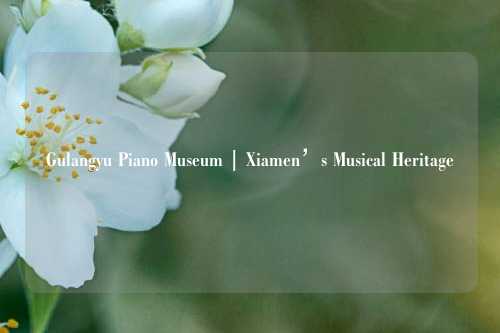Gulangyu Piano Museum | Xiamen’s Musical Heritage
A Haven for Music Lovers: Gulangyu Piano Museum
Located on Gulangyu Island off the coast of Xiamen, the Gulangyu Piano Museum offers visitors a journey into the rich musical history and cultural heritage of China. The museum, dedicated to the piano, houses an extensive collection of historical instruments, making it one of the most important cultural institutions in Xiamen. As a city that has long been influenced by both Chinese and Western cultures, the piano museum stands as a testament to the global impact of music and its role in bridging cultures.
Gulangyu Island itself is known for its peaceful ambiance, colonial architecture, and rich cultural scene, making it an ideal location for the Piano Museum. The island has a long history as a melting pot of cultures, and music has played a central role in its development. The Gulangyu Piano Museum celebrates this heritage by showcasing the island's significant role in China's musical history, with a particular emphasis on the piano's introduction and evolution.

Exploring the Museum's Extensive Collection
The Gulangyu Piano Museum boasts an impressive collection of over 200 pianos from different historical periods, which span a wide range of styles and design influences. Among its most prized possessions are antique pianos that date back as far as the 18th century, each telling a story of musical craftsmanship and cultural exchange. Visitors can see various types of pianos, from grand pianos to upright pianos, each with its own unique history and aesthetic.
One of the highlights of the museum is its collection of Western-style pianos that were introduced to China in the late 19th century, during the period of foreign influence in coastal cities like Xiamen. Many of these pianos were produced by world-renowned makers from Europe and the United States, including brands such as Steinway & Sons, Bechstein, and Blüthner. These pianos provide a fascinating glimpse into the technological advancements of piano design and how they influenced music in China.
The Role of Gulangyu in China's Piano History
Gulangyu Island is deeply intertwined with the history of piano music in China. The island's history as an international settlement created a unique environment where Western music and culture were introduced and flourished. In the early 20th century, the island became a hub for Western-style music, particularly classical piano music. Many foreign missionaries, diplomats, and expatriates brought pianos to the island, and it wasn't long before local Chinese musicians began to take an interest in learning to play.
Throughout the decades, Gulangyu has been home to several prominent pianists and music educators who helped to shape the development of classical music in China. The piano became an essential part of the island's social and cultural life, and its influence continued to grow throughout the 20th century. The Gulangyu Piano Museum preserves this important cultural legacy and continues to promote music education by inspiring new generations to explore the world of piano music.
A Walk Through the Museum: Discovering Musical Artifacts
As visitors walk through the museum's thoughtfully curated galleries, they will encounter a wide range of musical artifacts beyond just the pianos themselves. The museum displays various musical scores, photographs, and documents that help to paint a vivid picture of the piano's history on the island. These materials provide a deeper understanding of how the piano shaped the local culture and the artistic traditions that developed around it.
In one section of the museum, visitors can learn about the lives of prominent pianists and composers who have made significant contributions to the development of piano music in China. Portraits, manuscripts, and personal items shed light on the artistic journeys of these individuals, offering insights into their creative processes and musical achievements. The museum’s focus on the piano's impact on both the local and global music scenes provides a unique perspective on the evolution of piano music in China.
Musical Performances and Exhibits
In addition to its impressive collection of instruments, the Gulangyu Piano Museum regularly hosts a variety of musical performances, offering live renditions of both classical and contemporary piano music. These performances allow visitors to experience the beauty of the instruments in action and hear the distinct sounds that each piano produces.
The museum also organizes temporary exhibits that focus on specific themes related to the piano and its place in musical history. These exhibits often highlight different genres of music, famous pianists, or the development of piano technology. Through these rotating exhibits, the museum ensures that there is always something new to explore for returning visitors.
A Cultural Landmark of Xiamen
The Gulangyu Piano Museum is not just a museum, but a cultural landmark of Xiamen. The island itself has been recognized as a UNESCO World Cultural Heritage Site, largely due to its eclectic mix of architecture, which includes colonial-style buildings, traditional Chinese structures, and, of course, the historic music culture that continues to thrive there. The museum contributes significantly to the island’s cultural narrative, drawing music lovers, historians, and travelers from all over the world.
Gulangyu Island’s peaceful environment provides an ideal setting for visitors to take in the beauty of the museum’s exhibits, while also enjoying the island’s natural scenery. The museum is located within walking distance of some of the island’s other historic sites, such as the Shuzhuang Garden and the Gulangyu Organ Museum, which adds to the charm of a day spent exploring the island.
Piano Education and Community Outreach
One of the core missions of the Gulangyu Piano Museum is to promote piano education and foster a love for music within the community. The museum regularly hosts workshops, lectures, and masterclasses for students of all ages, from beginners to advanced pianists. These educational programs help visitors gain a deeper appreciation for the piano and develop their own musical skills.
Additionally, the museum collaborates with local schools and music academies to offer outreach programs, ensuring that the museum’s musical heritage is passed on to future generations. By engaging with the local community and offering a range of educational opportunities, the museum plays an integral role in fostering a musical culture that is rooted in both history and modernity.
The Architecture of the Museum: A Blend of East and West
The building housing the Gulangyu Piano Museum itself is a reflection of the island's history as a cultural crossroads between East and West. The architecture is a mix of colonial-era structures and Chinese traditional elements, representing the fusion of two distinct cultures. The museum's design complements the exhibits, creating a harmonious environment where the history of the piano and its global influence are celebrated.
The museum’s layout is both elegant and functional, with spacious galleries that allow visitors to move freely through the exhibits while also providing opportunities for intimate performances. Large windows offer views of the surrounding scenic vistas, including the nearby coastline and the lush greenery of Gulangyu Island. This setting adds to the overall experience of visiting the museum, making it not only a cultural and historical exploration but also a visual delight.
A Must-Visit Destination for Music Enthusiasts
For music enthusiasts and history buffs alike, the Gulangyu Piano Museum is a must-visit destination when in Xiamen. Its unique collection of pianos, along with its educational programs and performances, make it an enriching experience for all ages. Whether you are a musician, a lover of history, or simply someone looking to explore the cultural richness of Gulangyu Island, the museum offers an unforgettable journey into the world of music.
By preserving and showcasing the rich history of the piano on the island, the Gulangyu Piano Museum stands as a testament to the lasting legacy of music in Xiamen and China. Its blend of historical artifacts, live performances, and educational outreach ensures that the piano’s influence will continue to resonate for generations to come.
















